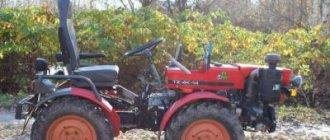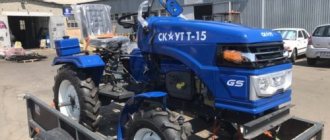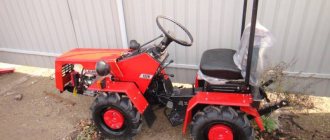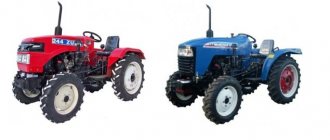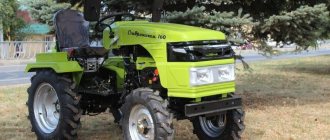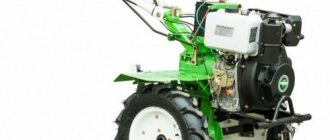The status of a leading manufacturer is assigned not only due to the extensive product range of a brand, but also due to the high quality of its products. This status was also awarded to the Japanese manufacturer of special equipment Kubota, which throughout its existence has developed more than 80 different models of mini tractors, both small and medium-sized. All manufactured equipment meets international quality standards, which is why the brand is very popular in many countries around the world, including Russia.
The series of mini tractors produced by this manufacturer includes several models distinguished by the power of the power plant. On average, this figure ranges from 18 horsepower to 32 horsepower. Due to its wide functionality, the equipment is especially in demand in gardens and orchards, livestock farming, small construction, as well as in landscaping. The B series has one of the outstanding models, which is the Kubota B6000 mini-tractor. This mini-tractor has at its disposal a wide range of additional mounted and trailed equipment, which allows it to perform a huge range of different agricultural tasks. The equipment can boast of its increased productivity compared to its predecessors, excellent maneuverability, versatility and relatively low diesel fuel consumption and lubricant consumption.
- 5.1 Reliability
Purpose
The wide functionality of the equipment allows you to perform a huge range of various works in gardens, livestock farming, small construction, as well as in landscaping.
This mini tractor is mainly used for various agricultural tasks, including: plowing a site with various soils, cultivating, harrowing, preparing the soil for sowing, sowing work, processing row crops, planting potatoes, harvesting potatoes, hilling up beds, collecting grown crops, cleaning fields or other areas from dry vegetation and debris, transporting crops for processing or to storage, and much more.
In other areas, the Kubota 6000 minitractor is used for transporting small loads, mowing grass and lawns, and for clearing any areas of snow and various debris.
Attachments
The versatility of the minitractor is largely due to the presence of an independent rear power take-off shaft, a three-point hydraulic system, as well as several remote cylinders, which provide the opportunity to use additional attachments, of which there are over 30 types. The equipment has a front-mounted device, thanks to which the following types of equipment can be used:
- Rotary grader.
- Front mounted blade.
- Front rotary blade.
- Bucket front loader.
Also, the Kubota 6000 minitractor is traditionally equipped with a rear three-point hitch and an independent power take-off shaft. They allow you to equip the machine with:
- Single-body lightweight plows.
- Double-furrow lightweight plows.
- Three-furrow lightweight plows.
- Rotary mounted potato plows.
- Mounted rotary cutters.
- Harrows.
- Mulchers.
- Mowers.
- Rotary mowers.
- Rotary mowers equipped with a cardan shaft.
- Lawn mowers.
- With a conventional mounted rake.
- Mounted rakes and tedders.
- Single-wing mounted tedder rake.
- Balers.
- Small drilling equipment.
- Rear mounted blade.
- Rear mounted body.
- Cultivators.
- Potato planters.
- Hillers.
- Cultivators-hillers.
- Potato diggers.
- Tipper tractor semi-trailer.
- Mechanical seeders.
- Grain seeders.
- Spreaders of mineral fertilizers.
- Wood waste shredder.
- Rippers-levelers.
An interesting feature of the machine is that in addition to the original attachments (all of the above), it can also be used by many others, originally intended for assembly with certain models. This is explained by the fact that this mini-tractor has very well-thought-out connections that coincide with most other units, both European and domestic machines. All equipment, including original ones, is selected, taking into account the power indicators of the equipment and load capacity.
Specifications
Dimensions:
- The structural length of the mini-tractor is 2150 millimeters.
- Full width – 960 millimeters.
- Total height – 1750 millimeters.
- The lowest ground clearance is 250 millimeters.
- Wheelbase (longitudinal) – 1165 millimeters.
- The smallest front track width is 980 millimeters.
- The smallest rear track width is 1050 millimeters.
- The largest front track width is 1190 millimeters.
- The largest rear track width is 1250 millimeters.
- The smallest turning radius is 2800 millimeters.
Engine characteristics:
- The type of engine installed is diesel, in-line.
- Number of cylinders – 2 cylinders.
- Maximum power – 15 horsepower/11 kilowatts.
- The highest crankshaft rotation speed is 3000 rpm.
- The total volume of the cylinders is 898 cubic meters.
- Type of cooling system – liquid.
- Type of injection system – direct fuel injection.
- Type of lubrication system - oil pump.
- The lowest fuel consumption per working hour is 1.2 liters.
- The highest fuel consumption per working hour is 2.3 liters.
Transmission characteristics:
- The type of gearbox installed is mechanical.
- Drive type – plug-in all-wheel drive.
- The differential lock is mechanical.
- Number of forward gears – 6.
- Number of reverse gears – 2.
- Clutch type – dry, single-disc in a permanently closed position.
Characteristics of the power take-off shaft:
- The type of PTO installed is independent.
- The number of power take-off shaft speeds is 3.
- Control is mechanical.
- The lowest PTO rotation speed is 540 rpm.
- The highest PTO rotation speed is 1150 rpm.
Hydraulic system characteristics:
- The power of the hydraulic pump is 11 liters per minute.
- The maximum load capacity of the rear device is 500 kilograms.
Performance characteristics:
- Operating weight – 475 kilograms.
- Fuel tank capacity is 18 liters.
- Type of hitch – three-point.
- Steering type: hydraulic.
- Processing width – 1000 millimeters.
- Load capacity – 500 kilograms.
Engine
The Kubota B 6000 is equipped with a 4-stroke diesel unit. The motor is manufactured at the Japanese Kubota plant. The engine has a forced liquid cooling system, direct fuel injection and combined lubrication. The power plant operates effectively in Russian conditions and when using low-quality fuel. The elements of the unit are characterized by an increased service life. The motor has a winter start mode, a feature important for consumers from regions with cold climates.
Engine characteristics:
- working volume – 898 cc;
- rated power – 12 (15) kW (hp);
- highest rotation speed – 3000 rpm;
- number of cylinders – 2 (in-line arrangement);
The range of fuel consumption is from 1.2 to 2.3 l/hour. The fuel tank of the minitractor holds up to 18 liters.
Device Features
This mini-tractor is an ideal option for working in Russian regions. This is explained by the fact that the Kubota 6000 model has full adaptation to harsh operating conditions, this can be either a fairly low ambient temperature, or, on the contrary, abnormally hot. With all this, the equipment fully retains its functionality. Moreover, the machine is considered one of the best in its class, since it differs from analogues in its significantly increased service life. The mini-tractor can boast of its high efficiency, which was achieved thanks to the power take-off shaft, which has a three-speed operating mode and an improved switch that operates in a floating mode and the forced deepening of additional means intended for tillage.
Despite the fact that the model belongs to the class of compact special equipment, the manufacturer has endowed it with hydraulic power steering, modern lighting equipment, as well as a locking rear axle differential, which can significantly increase the vehicle's cross-country ability.
Kubota B6000 stands out for its mass of features and advantages, which are responsible for the great popularity and demand for the model not only in Japan, but also in the European and Russian markets for special equipment.
The minitractor has excellent driving performance, which provides increased maneuverability compared to similar models. This indicator is especially important when working in confined spaces, such as vegetable gardens, greenhouses and orchards.
The relatively small weight of the machine allows it to be used on soft soils. Also, thanks to this, the machine does not cause significant damage to the fertile soil layer, which is a common problem with conventional agricultural tractors.
Reliability
Each element of the mini-tractor, in particular the attachments, is of fairly high quality. According to this indicator, the equipment fully complies with modern quality standards. The use of high-quality materials made it possible not only to achieve an increased service life, but also provided the opportunity to fully achieve the service life declared by the manufacturer. Thus, the equipment will not require large financial investments for repairs.
Like many other models, this one is famous for its unpretentiousness, both in terms of operating conditions and the quality of diesel fuel consumed.
Repair features
Maintenance of the Kubota B6000 minitractor does not have any specific issues and is quite simple. All the car owner is required to do is:
- Carry out timely maintenance of the tractor, which allows you to increase the life of the mini-tractor.
- Regularly check the main components and assemblies for their functionality and integrity.
- Regularly replace consumables, namely oil, filters, hydraulic fluid, and so on.
- Check the RTI.
- Timely prepare equipment for seasonal operation in the autumn-winter and spring-summer periods.
Kubota
Manufacturer Information Create products with your heart and soul and bring to life the product values of such products in the correct definitions.
Founder of the group KUBOTA Gonshiro Kubota
Kubota began its business by manufacturing and selling die-cast metal products.
Since then, we have offered a variety of products that contribute to improving the lives of people and society. We will strive to improve the technical capabilities acquired throughout our history by expanding and deepening them, expanding the boundaries of our business and making a greater contribution to society. Kubota Product History (Global Site)
1890 Founded as a foundry. Start of production of castings for weighing equipment and everyday products.
1893 Start of production of cast iron pipes for water supply. Opening of the Amagasaki plant in 1917 and relocation of production.
1897 Change of company name from Oide Chuzo-yo (Oide Foundry) to KUBOTA Tekko-yo (KUBOTA Iron and Steel Works). Start of production of equipment for hydraulic structures, such as fire hydrants and valves.
1922 Start of production of oil-based engines for agro-industrial purposes, settanki (fuel economizer: energy-saving equipment using waste gases) and heat-resistant cast iron.
1930 The Ministry of Trade and Industry selected KUBOTA oil-based engine as the "Superior Domestic Product".
1939 Initial public offering of shares. A vocational institute has been established at each plant.
1947 Development of the cultivator and start of production and sales.
1953 Company name changed from K.K. KUBOTA Tekko-yo on KUBOTA Tekko K.K. Establishment of KUBOTA Kenki K.K. and entry into the construction equipment industry. Start of production of excavators and other construction equipment, as well as marine deck mechanisms.
1955 Creation of the corporate motto - “From country construction to rice cooking.”
1957 A leading company in the home materials arena. Start of production of material for the home under the “Colorbest” brand.
1960 Development and commercialization of the first Japanese field tractor. Receiving and completing an order for an overseas water supply project (Phnom Pan) for the first time in Japan.
1962 Full access to commercial activities to improve the environment. Start of production of tractors used in rice fields.
1963 Start of production of vending machines.
1964 Creation of municipal waste incineration plants.
1969 A new motto has been launched. Start of production of combines. The creation of an integrated system for agricultural mechanization has been completed.
1972 Full access to incinerators. Creation of the KUBOTA tractor corporation in the USA for full entry into the US tractor market.
1980 Receiving an order for an irrigation system from Sharqia State, Egypt, and working on desert landscaping. Launching a new motto - “Chasing the Promised Future by Leveraging Our Technological Strength.”
1984 Receiving an environmental award from the Environmental Protection Agency for the stool treatment system - YouTube Nitro System.
1986 Start of production of electronic circuit boards, hard drives and radio-controlled lawn mowers.
1989 Participation in desert greening projects, Shahila Green Belt Plan and Green Land Plan.
1990 Celebrating 100 years of commercial activity. Change of company name to KUBOTA Corporation. Introducing a new corporate symbol and visual identity system. Joint presentation of the fountain and ALEPH water splitting equipment at the international garden and greenhouse exhibition.
1992 Launch of a new slogan - “Let's make our living environment more beautiful.” Beginning of research and development on incineration plants with high-efficiency waste from an energy facility. With the support of a donation from KUBOTA Corporation, a center for international environmental planning was established at the Faculty of Engineering of the University of Tokyo.
1993 The main lines of commercial activity are stated: “Vision of our second century in commercial activity” on the way to the 21st century. Kangkuo Chosa Center and Nikkan Koguo Shimbun awarded the CEO Award and EPA Honors Award for our domestic submersible flat membrane wastewater treatment system.
1995 Launched an environmental audit system to protect the environment to more stringent standards than existing laws and regulations, towards continuous environmental improvement.
1999 Our underwater dioxin decomposition device has won the Nikkei Outstanding Product Award/Service Award and the Nikkei Shimbun Excellence Award.
2001 All of our local institutions have received ISO 14001 certification.
2002 The total production volume has exceeded 20 million units for our industrial motor.
2005 Our Teshima illegal waste raw material recovery system won the Ministry of Economy, Trade and Industry's Best Environmental Equipment Award. The total production volume has exceeded 3 million units for our tractors.
2006 The “Mission of the Corporation”, “Principles of Management”, “Charter of Actions” and “Rules of Conduct” of the KUBOTA Group are formulated. New corporate mottos were created: “Laying the foundations” (main motto)”, “For water, soil, air and people’s lives. (sub-motto)” and “Let’s make our living environment more beautiful (sub-motto).” Our “Sewage sludge concentrator (belt type)” won the prize of the Ministry of Economy, Trade and Industry at the Best Environmental Equipment Award.
2008 Started the “Kubota E-Project” social contribution activites.
2009 Completed the first tractor production plant for a Japanese company in Thailand. (Siam Kubota Tractor Co.,Ltd.) Completed a ductile iron pipe plant in India. (Tata Metaliks Kubota Pipes Limited (TMKPL))
2010 Certified as an "Environmentally Friendly Company" by the Japanese Ministry of Environment. Began production of grain harvesters in Thailand (SIAM KUBOTA Corporation). Established a company for the production and sale of pumps in China (Anhui Kubota Sanlian Pump).
2011 Kubota's PRO688Q combine harvester for the Chinese market has won the 2010 Nikkei Business Daily Awards for Best Products and Services. The company has established a regional office in China. The company launched a certification system for eco-products. Completed the creation of a steel plant in Saudi Arabia (Kubota Saudi Arabia Company). The company has completed the construction of a machine-building plant in China (Kubota Construction Machinery (Wuxi)). Established a company specializing in the import, processing and sale of Japanese rice in Hong Kong (Kubota Rice Industry(HK) CO., Ltd.)
2012 The company acquired and transformed Kverneland AS into a subsidiary. The company established an engine manufacturing plant in China (Kubota Engine (WUXI) Co.,Ltd.), established the "Kubota Identity", global corporate guidelines, and adopted a new brand statement as its logo. Acquired a water treatment engineering company and created the KUBOTA KASUI Corporation.
2013 Founded a company for the purchase of parts in Thailand. Founded a plant for the production of mini tractors in the USA. Founded a company specializing in the import, processing and sale of Japanese rice in Singapore (Kubota Rice Industry (Singapore) PTE Ltd.)
2014 Founded a company for the production of mountain agricultural tractors in France (Kubota Farm Machinery Europe SAS)
Information taken from the official website kubota-global.net
Price
On average, a Kubota B6000 minitractor with zero mileage can be purchased at a cost ranging from 280 thousand rubles to 390 thousand Russian rubles, depending on the configuration (this also includes additional attachments), year of production, and modification of the mini-tractor.
A used tractor has a cost ranging from 170 thousand rubles to 235 thousand Russian rubles. The final cost of equipment, as a rule, varies depending on the year of production, the number of working hours worked, the general technical condition and additional attachments. You can purchase this option both from official dealers and from private sellers.
User manual
This document must be studied without fail by new owners of Kubota equipment.
Start of operation
Kubota mini tractors must be run in during the first 7-10 hours of operation. In this mode, the maximum load on the motor should not exceed 30%. During break-in, all parts of the Kubota mini tractor will be lubricated and begin to work as a single unit. At the end of this procedure, owners should change the oil.
Conservation
You should not only know the rules for the first launch, but also the subsequent use of the equipment. If you need to put the mini tractor into storage, the operating instructions advise you to perform the following steps:
- Place the mini tractor in the garage;
- Drain fuel and oil;
- Disconnect the terminals from the spark plugs and remove the battery;
- Release tire pressure;
- Clean off any remaining dirt and dust to prevent corrosion on the machine body.
Owner reviews
- Far from new, the 15-horsepower Kubota mini-tractor pleases with good traction characteristics for its class and economical operating costs. The range of spare parts offered is small; you have to spend quite a lot of time searching for cheap consumables.
- I respect Japanese technology for its quality and durability, so when purchasing a small Kubota tractor there were no special doubts. The reliability of the machine is many times higher than its Chinese counterparts. Among the shortcomings, it should be noted the low interchangeability of the repair range with similar machines of other brands.
- Reliable and durable Japanese Kubota equipment is not only multi-functional and high performance, but also quite expensive equipment that requires certain skills and skills. What outweighs all this is up to each individual to decide.
Modifications and features
Kubota B 6000 represents the “B” series and is available in a single variation. The model offers many options and additional equipment. Analogs of equipment include small-sized machines Forte T-151EL, Fighter T-15 and Garden Scout T-15.
Features of the mini tractor:
- equipment and fittings meet international standards and are characterized by significant quality, which allows the machine to fully achieve the service life declared by the manufacturer;
- unpretentiousness in fuel. For the Russian consumer, this factor is of great importance. When using technology, you can save on the purchase of expensive fuel;
- mobility and maneuverability;
- high driving performance in comparison with similar mini tractors;
- considerable mass. For work involving soil, this indicator plays an important role, since it allows maintaining the integrity of the earthen covering and reducing damage to the soil structure.
Kubota B 6000 is one of the most successful models of the manufacturer. However, it is not without its drawbacks:
- Compared to similar machines, the cost of a mini tractor is significantly higher. For small farms, this factor is sometimes decisive;
- complex controls. The model is multifunctional and requires special skills. The Kubota B 6000 manual is only available in Japanese, which creates additional complications (however, its presence provides confidence that the consumer is buying a genuine product);
- shortage of equipment and spare parts. The mini tractor works exclusively with original elements, which are offered only at the company’s representative offices. The cost of factory spare parts is usually significantly higher than that of competitors;
- significant risk of accidental breakdown. limited experience in operating such equipment and increased demands on the operator increase the likelihood of incorrect actions that can lead to machine failure.
